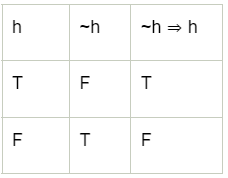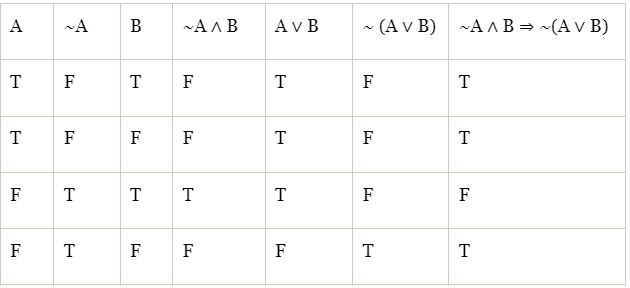Tautologies & Contradictions | Engineering Mathematics - Engineering Mathematics PDF Download
Tautology in Discrete Mathematics
A tautology is a compound statement that will always be true for every value of individual statements. A Greek word is used to derive the tautology where 'tauto' is known as "same" and "logy" is known as logic. There are some conditional words, which is used to make a compound statement, i.e., if, then, and, or, not, and if and only if. We will use these words in the middle of two simple statements. For example: Suppose there are two given statements, A and B. Here, (A ⇒ B) ∨ (B ⇒ A) is a tautology.
There are some simple examples of tautology, which are described as follows:
- Jack is a good boy, or Jack is not a good boy.
- Either he will choose to study biology, or he will not choose to study biology.
- A number can be even, or a number cannot be even.
Tautology in Discrete mathematics
- The tautology can be described as a compound statement, which always generates the truth value. The individual part of the statement does not affect the truth value of the tautology. The tautologies can be easily translated into mathematical expressions from the ordinary language by using logical symbols. For example: My uncle gives me 100 rupees or my uncle will not give me 100 rupees.
To understand this example, we will take:
- P = My uncle gives me 100 rupees
- ~P = My uncle will not give me 100 rupees (Since this statement is the opposite of statement P).
The logical operator "OR" is used to generate the above two individual statements, which is indicated with the help of symbol "∨".
So these statements can be written in the following form:
- P ∨ ~P
Now we have to determine whether the above two given statements generate a valid answer.
- Case 1: My uncle gives me 100 rupees. Here, the true value is generated by the first statement, and the false value is generated by the second statement. With the help of 'OR' operator, the given statement is connected. That's why it will generate a truth statement.
- Case 2: My uncle will not give me 100 rupees. Here, the false value is generated by the first statement, and the true value is generated by the second statement. That's why it will generate a true statement.
Now we will describe this statement by the truth table, which is described as follows:

Hence, the last column of the above table is true for all the values. That's why we can say that the given statement is a tautology.
Tautology Logic Symbols
- The compound statements can be represented with the help of tautology which uses different logical symbols. The various types of symbols, their meaning, and representation used in discrete mathematics are described as follows:
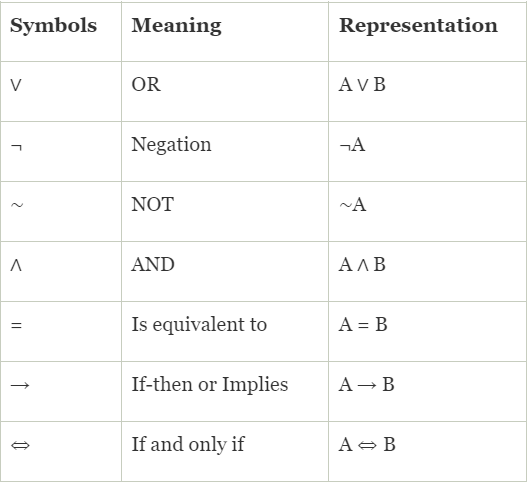
Tautology Truth Tables
- The simple statements can be connected with the help of logical symbols, which will define a compound statement. This process is known as logical operations. In discrete mathematics, there are five major logical operations, which will be performed with the help of some symbols, i.e., AND, Conditional, OR, NOT, and Bi-conditional. Suppose there are two statements, A and B.
- With the help of truth table, we will explain these symbols with their operation. The definition of tautology can also be explained in a simple way with the help of truth table. Various types of compound statements and logical statements can be tested with the help of truth table. Now we will learn the construction of truth table.
- The first column of the truth table is used to indicate the first part of a compound statement. The second column of the truth table is used to indicate the second part of a compound statement. The logical connector like or, and, not, etc, follows this second part. These logical statements are used to provide the meaning of a compound statement. The relation between these two statements is contained in the third column of the truth table. The given compound statement will be tautology if and only if the result of third column is true (T). Now we will use the truth table to describe all of these symbols, their operations, and meaning. All the symbols are described as follows:
AND operation
- The symbol ∧ is used to indicate the AND operation. If we use the AND symbol to form the two simple statements and make a compound statement, then it will be known as the conjunction of two statements. Suppose there are two statements, A and B. The AND operation between A and B is described by a truth table, which is described as follows:
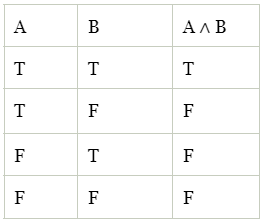 OR operation
OR operation
- The symbol ∨ is used to indicate the OR operation. If we use the OR symbol to form the two simple statements and make a compound statement, it will be known as the disjunction of two statements. Suppose there are two statements, A and B. The OR operation between A and B is described by a truth table, which is described as follows:
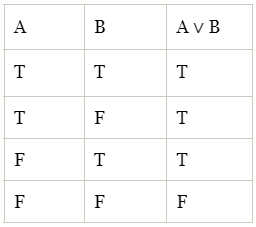
NOT operation
- The symbol ∼ is used to indicate the NOT operation. If we are using the NOT symbol to change the truth value of a statement, then it will be known as the negation of a given statement. Suppose there is a statement A. The NOT operation on A can be described by a truth table, which is described as follows:
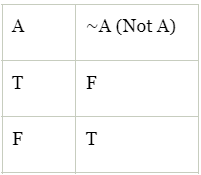 Conditional operation
Conditional operation
- The symbol ⇔ is used to indicate the conditional operation. If we use the "if and then" symbol to form the two simple statements and make a compound statement, it will be known as the conditional operation. Implies symbol is also used to represent the conditional operation. Suppose there are two statements, A and B. The Conditional operation between A and B is described by a truth table, which is described as follows:

Bi-Conditional operation
- The symbol ⇔ is used to indicate the Bi-conditional operation. If we use the "if and only if" symbol to form the two simple statements and make a compound statement, it will be known as the bi-conditional operation. Suppose there are two statements, A and B. The Bi-Conditional operation between A and B is described by a truth table, which is described as follows:
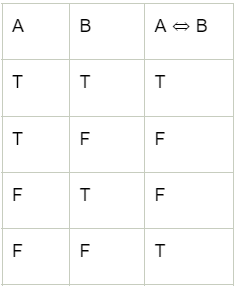 Examples of Tautology
Examples of Tautology
There are various examples of tautology, which are described as follows:
Example 1: In this example, we have to determine whether the statement ~h ⇒ h is a tautology.
There is a statement h. Truth value of this statement can be written in the following form:
With the help of above table, we can see that the truth value of ~h ⇒ h is {T, F}. That's why this statement is not a tautology.
Example 2: In this example, we have to determine whether the statement p ⇒ (p ∨ q) is a tautology.
There are two statements, p, and q. Truth value of these statements can be written in the following form:
With the help of above table, we can see that the truth value of p ⇒ (p ∨ q) is true for all the individual statements. That's why this statement is a tautology.
Example 3: In this example, we have to determine whether the statement ~A ∧ B ⇒ ~(A ∨ B) is a tautology.
There are two statements, A, and B. Truth value of these statements can be written in the following form:
With the help of above table, we can see that the truth value of ~A ∧ B ⇒ ~(A ∨ B) is true for all the individual statements. That's why this statement is a tautology.
Tautology and Contradiction
- In the above explanation, we have learned the term tautology. The opposite of tautology is known as the contradiction. Suppose we use the two statements to form a compound statement with the help of logical operations. If its result is false, then it will be known as the compound statement. The contradiction is also known as the fallacy. For example, suppose there are two statements, A and B. If (A ⇒ B) ∨ (B ⇒ A) is a tautology, in this case, ~(A ⇒ B) ∨ (B ⇒ A) will be a contradiction or fallacy.
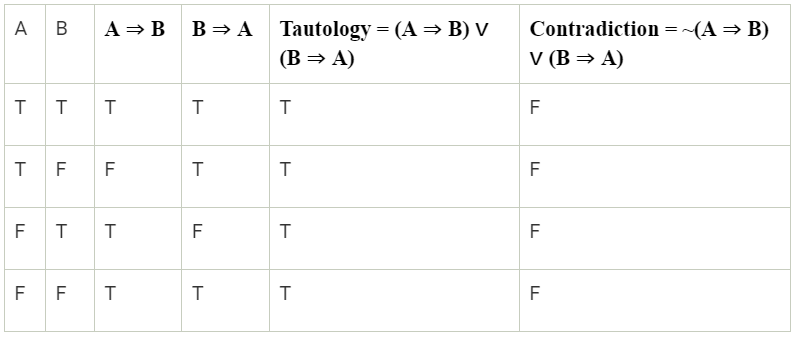
|
65 videos|129 docs|94 tests
|

